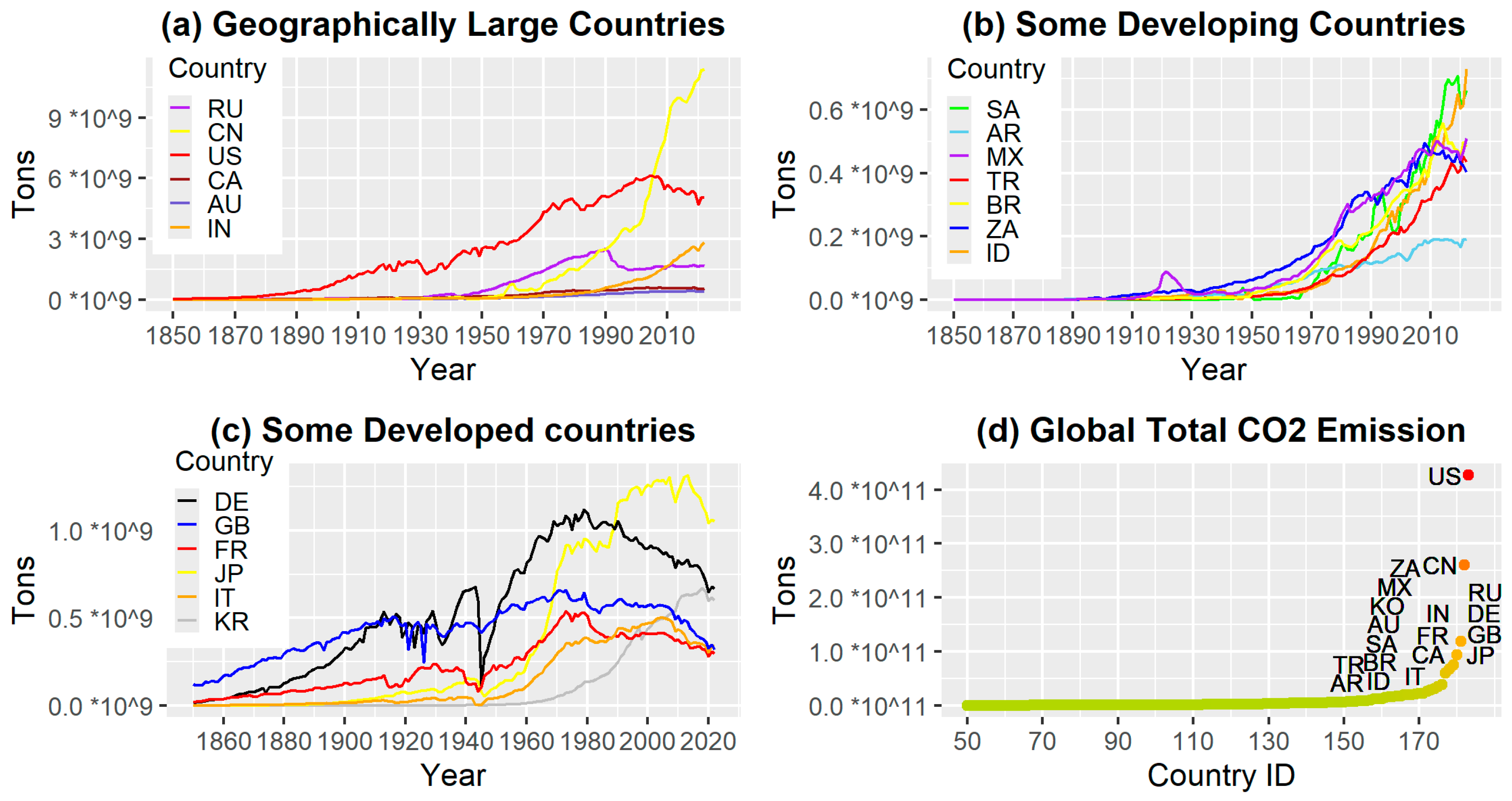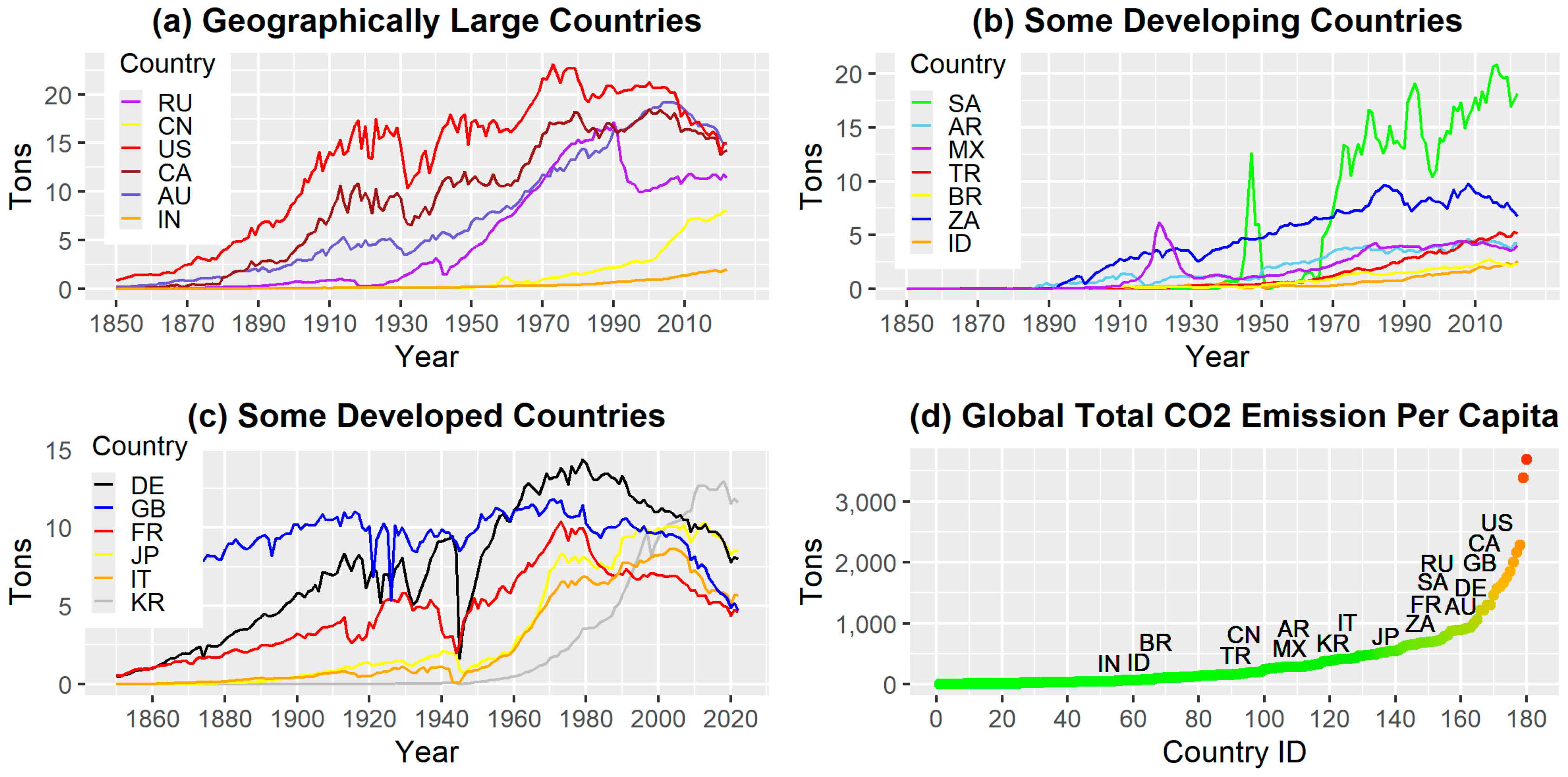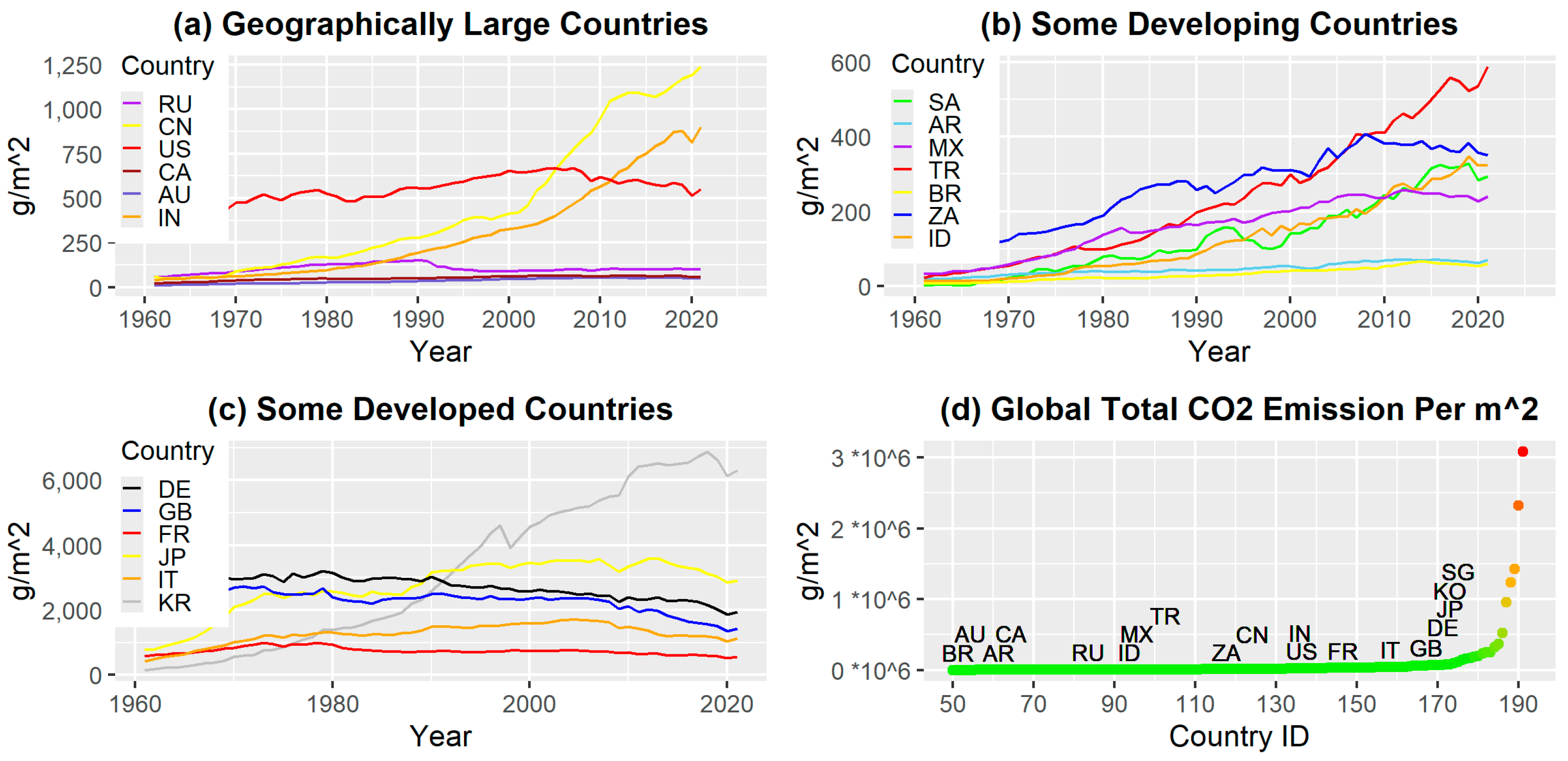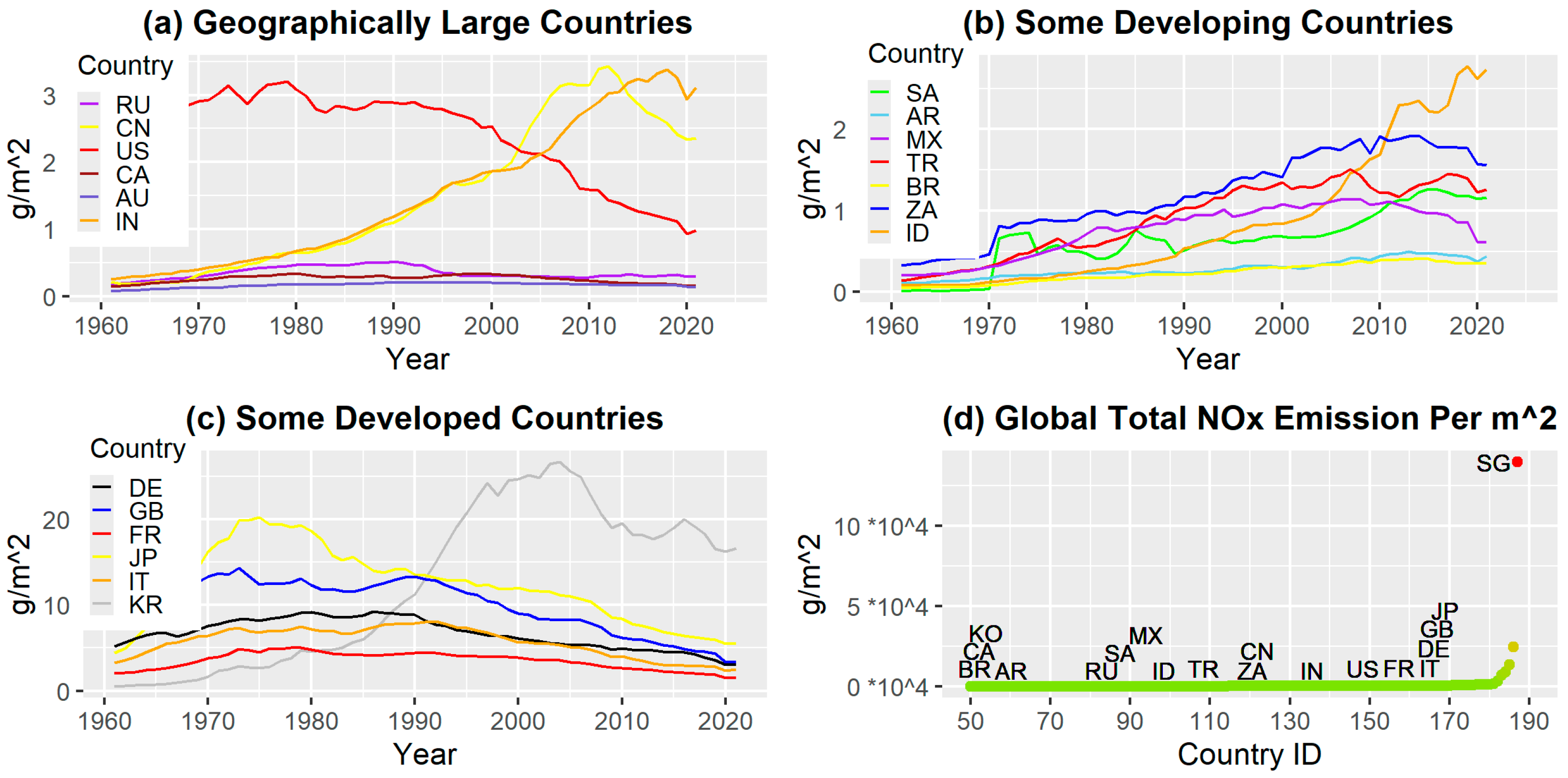1. Introduction
EAQ is defined based on general air quality (AQ) and takes into account the impact of excessive emissions of greenhouse gases. An excellent EAQ significantly impacts daily life, the national image, and human development. EAQ varies across countries and times at different development levels. Poor EAQ endangers both the physical and mental health of a country’s residents. Furthermore, such countries may decrease the EAQ of the earth if they do not take effective measures to control their EAQ, such as the acid rain problem from the 19th century to the present [
1,
2], the smog from the 20th century to the present [
1,
3], and global warming [
4,
5,
6]. Therefore, it is vital to assess the average duration of EAQ control globally across countries, summarize the control experiences of countries with excellent EAQ, and provide suggestions to those facing significant EAQ challenges.
Freeman [
7] discusses how the net benefit of environmental policies for a country in the past is useless, but there is value in understanding how to change measures to improve the current net benefit. The EAQ in each country is influenced by industrialization and modernization processes. In retrospect, in countries where EAQ has been historically strongly controlled, it can return to an excellent level with substantial effort. Various organizations and countries have developed air quality standards. However, their estimation models are similar when the max–min normalization method is used [
8,
9]. The United States Environmental Protection Agency (EPA) introduced the Air Quality Index (AQI) in 1999, which includes factors such as particulate material 2.5 (PM
2.5), ozone, SO
2, carbon monoxide (CO), and nitrogen dioxide (NO
2). A revised AQI shows that the ratio of PM
2.5 to PM
10 is greater in southern cities of Taiwan Province, China, than in central or northern cities [
10]. Other countries, such as mainland China, Europe, the United Kingdom, and Canada, have established AQIs. Modern monitoring technologies have made it easier to access EAQ factors [
9]. Li et al. [
11] transfer the concentrations of SO
2, NO
x, and PM
10 to air quality indices via the max–min normalization method, using the proportion of the air quality sub-indices SO
2, NO
x, and PM
10 in the total index as their initial weights. However, the observations years in Li et al. [
11] span from 2016 to 2020, which are insufficient for inferring long-term trends in air quality indicators. This study focuses on long-term EAQ trends, which are challenging to obtain for insufficient monitoring systems.
The Kaya model [
12] effectively illustrates carbon emission processes. However, the model focuses on carbon emission flow rather than emission stock [
13,
14]. The Kaya model also cannot directly depict the changes in carbon emissions over time. Additional studies [
12,
15] employ the environmental Kuznets curve (EKC) to assess the impact of carbon emissions on economic development, and the results reject the assumption of the significant relationship between carbon emissions and economics. Ru et al. [
16] investigate potential EKC relationships between per capita income and EAQ factors such as SO
2, CO
2, and black carbon. With respect to the assessment and perspective of the EAQ, Andres et al. [
17] shows that the trends between per capita CO
2 and income levels in developing countries would have a similar “inverted U” path that developed countries have gone through. Lanne and Liski [
18] highlight that historical emission trends of per capita CO
2 by fossil fuel combustion began to decline in the 1970s based on the data of early developed countries from 1870 to 1998. Zhong et al. [
19] show that emissions activity is the predominant source of global annual SO
2 increase, with the percentage of SO
2 emissions in developing countries at present being greater than that in developed countries in the 1960s. Huang et al. [
20] illustrate significant disparities among annual and per capita NO
x emission and its emission intensities, and report that per capita emissions follow an inverted U-shaped EKC. While these articles specifically discuss the relationship between the EAQ factor and time or income levels, none provide a comprehensive long-term trend analysis or assessment. This study primarily focuses on long-term trend analyses and assessments of EAQ indicators.
In this study, three key EAQ factors are considered: CO
2 emissions from fossil fuel combustion, SO
2 emissions from coal and oil combustion in residential heating, and NO
x emissions from vehicles and industrial activities [
21,
22]. These elements are the primary sources of greenhouse effects, acid rain, and ground-level ozone, respectively. SO
2 and NO
x are the primary air pollutants, and the excessive emission of greenhouse gases such as CO
2 may damage the global environment [
4,
5,
6]. Numerous studies discuss carbon peak and carbon neutrality [
23,
24]. Many countries, especially developed countries, have already reached their carbon emission peak, while many provide pledges and schedules for carbon neutrality [
15,
25,
26]. Liu et al. [
27] argue that provinces such as Guangdong, Zhejiang, and Jiangsu may achieve a carbon peak before 2030, potentially ahead of China’s national commitments, whereas other provinces may lag. Yang et al. [
15] also present an evaluation index system of carbon peak and carbon neutrality across Chinese provinces, indicating that provinces with higher scores may more readily achieve these targets. The reasons that other air factors are not suitable for analyzing and estimating EAQ are as follows: the air pollutant CO is excluded from the analysis due to its strong correlation with SO
2 and NO
x. Particulate matter (PM
2.5 and PM
10) can be formed secondarily from SO
2 and NO
x and is also omitted [
28,
29]. Ozone, a secondary pollutant primarily generated through photochemical reaction with NO
x, is likewise excluded [
30,
31]. Moreover, nitrogen monoxide (NO) and NO
2, the two principal components of NOx, are produced in the gas of vehicles and the combustion of fossil fuels [
21,
22]. Given that NO is readily transformed to NO2 by chemical reactions with ozone in the air, NOx serves as the reasonable and representative factor for assessing EAQ.
The significance of this study is as follows. First, the impact of CO2 emissions on the EAQ was examined, along with the assessment of classical air quality factors such as SO2 and NOx, which are measured similarly to CO2. Given the differences in population size and geographic area among countries, considering only the annual emissions of these three factors would lead to bias in analysis and assessment. Therefore, emissions per capita and per are integrated with annual emissions for these three factors to comprehensively evaluate the long-term EAQ of global countries. In addition, some emission rebounds that occur after emission standardization in some countries are given. Second, a regression analysis of the EAQ is conducted from an energy structure perspective. Third, an EAQ ranking model, along with its validation of robustness for global countries, is presented. The primary works of this research include estimating the average duration of EAQ control, assessing the EAQ among various countries, establishing an EAQ ranking model for global countries, summarizing the control strategies of countries with excellent EAQ, and advising countries with critical EAQ challenges.
The remainder of the paper is structured as follows.
Section 1 shows the introduction and literature review of the research.
Section 2 through
Section 4 are structured as three integral components.
Section 2 constitutes the first part, in which the key indicators influencing EAQ are identified and described.
Section 3 serves as the second part, analyzing the impact of these air quality factors on EAQ. The third part, presented in
Section 4, provides a global assessment of EAQ ranking scores and discusses strategies to address associated challenges.
Section 5 concludes this study.
3. Impacts of Energy Structures on AQ
Section 2 provides a comprehensive analysis of the current global EAQ situation and outlines the expectation for the duration of control for global countries by illustrating the emission peak and standardization of every EAQ indicator. Alvarez-Herranz et al. [
42] report a strong relationship between energy structure and AQ using the EKC method. This section highlights the influence of the percentage of the electricity consumption structures on AQ. The energy structures in this study include biofuels, solar, wind, hydropower, nuclear, gas, coal, and oil. The regressions of causal effects between these energy compositions and air quality for global countries from 2010 to 2019 are established as follows:
where
is the vector representing the PM 2.5 index,
is the intercept vector representing vector
or
,
denotes the intercept coefficient, and
represents the vector of the
-th energy consumption ratio. The coefficient
corresponds to
,
denotes the disturbance vector, and the set
consists of energy consumption factors, which are indexed from 1 to 8, representing biofuels, solar, hydropower, wind, coal, and oil, respectively. Note that
differs from the regressors used in the various OLS models in
Table A6. The
-th energy consumption ratio
is derived from the
-th energy consumption with the unit of terawatt-hour (TWh) divided by the total energy consumption (TWh).
Table A6 presents the ordinary least squares (OLS) estimations for the impact of energy consumption structures on air quality. The regressions OLS (1) to (4) in
Table A6 demonstrate that wind power has improved the EAQ significantly, and a 1% increase in wind power consumption is associated with an approximate decrease of 58.99 in the AQI. The effect of biofuel power is massive, with a decrease of approximately 147.63 in the AQI when there is a 1% increase in power consumption, yet there are endogeneity issues between biofuels, gas and coal powers in comparison with OLS (1), (3), and (4) in
Table A6. Hydropower, a type of green energy, has a slight decrease of 11.35 in the AQI when there is a 1% increase in power consumption. Hydropower also has endogeneity issues, as in OLS (4) in
Table A6. However, solar energy does not have a distinct effect on improving the EAQ, as its coefficients are insignificant in all regressions. Jha and Leslie [
43] report that an increase in the solar power consumption market may lead to an increase in the start-up cost of fire power. The air quality is insensitive to the increase in rooftop solar capacity at sunset. Fossil fuel energy sources, such as gas, coal and oil, decrease the EAQ where the passive effect of coal is preponderant. A 1% increase in coal power consumption is associated with an increase in the AQI of approximately 38.88.
5. Conclusions
This study presents a comprehensive EAQ assessment for global countries. The assessment results are instrumental in countries facing severe EAQ challenges taking advanced actions to control and improve their EAQ. This study outlines EAQ control progress, estimates the expectation for the duration of control, and proposes a rebound phenomenon after emission reaches standardization. France, Germany, the United Kingdom, and other countries that fall within the excellent and good ranking intervals have achieved emission peak and standardization and have successfully managed their EAQ factors at an excellent level. Countries such as India, Turkey, and Indonesia have not reached emission peaks for all indicators. These countries without emission peaks will experience a deterioration in the EAQ without advanced action to control emissions. Moreover,
Table A2,
Table A3 and
Table A4 show the statistical average year length of control of CO
2, SO
2, and NO
x. These findings offer preliminary insights into the global EAQ landscape.
In some countries with emission standardization, there have been rebounds and increases in emissions during the COVID-19 pandemic. This rebound phenomenon will be further discussed later when the data are sufficient. The analysis of energy consumption reveals that biofuel and wind power significantly improve the EAQ, whereas gas, coal and oil have detrimental impacts. Hydropower and nuclear power are insignificant in some regressions in
Table A6 and their impact on the EAQ is uncertain.
Moreover, EAQ factors are characterized by three attributes, namely, annual, per capita, and per
emissions, rather than solely focusing on total annual emissions. These EAQ indicators are incorporated into a long-term EAQ ranking model that is also called the adjusted max–min normalization model.
Table A8 shows a brief ranking result of this model. The detailed ranking results can be found in the
Supplementary Materials. The robustness tests of the ranking model are given in
Section 4.2. Additionally, two main strategies, replacement and absorption, are proposed for countries falling within the heavily polluted interval of the EAQ. In summary, controlling and improving EAQ is feasible, as evidenced by the significant progress made by many countries over several decades. However, this progress is not instantaneous and requires sustained efforts over a long time period. With advancements in control technologies and effective measures implemented by government, industries, and individuals, all EAQ factors are expected to decrease significantly.
















